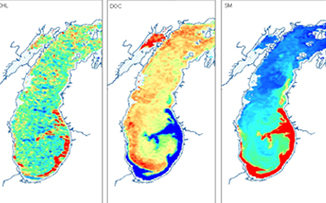Michigan Tech Research Institute (MTRI) and the Nansen International Environmental and Remote Sensing Center (NIERSC) of St. Petersburg, Russia have developed a new algorithm for the retrieval of color producing agents (CPAs) for the Great Lakes. The algorithm is applicable to all coastal and inland waters, and operates on either multi-spectral (MODIS, SeaWiFS) or hyper-spectral (Hyperion, AVRIS) data and produces estimates of chlorophyll, dissolved organic carbon, and suspended minerals. The algorithm has undergone a preliminary validation using both dedicated and historical /in situ/ water chemistry measurements. See Pozdnyakov, Shuchman, Korosov, and Hatt (2005) for a more extended description.

The new, fast-operating algorithm is based both on a previously developed hydro-optical model developed for Lake Ontario (Bukata, et al., 1995) and a combination of the Levenberg-Marquardt (L-M) multivariate optimization approach with a neural network (NN) emulation technique. The NN emulator provides the L-M procedure with reasonable initial constraints, which makes the final solution of the L-M procedure more accurate. It also speeds up the retrieval algorithm performance significantly.
A seven-year time-series analysis of Lake Michigan was reported in Shuchman et. al. (2006). It used the results of the algorithm to identify seasonal biogeochemical events, and well as to predict the results of climate change in the Great Lakes basin. The paper won the Chandler-Misener award for 2006, given by the International Association for Great Lakes Research (IAGLR) for outstanding research about the Laurentian Great Lakes.

